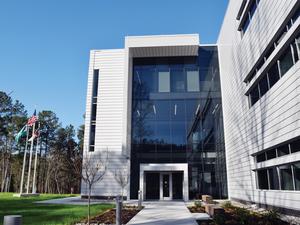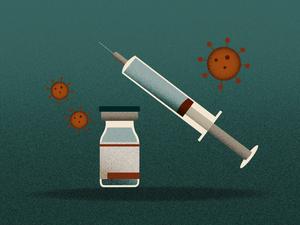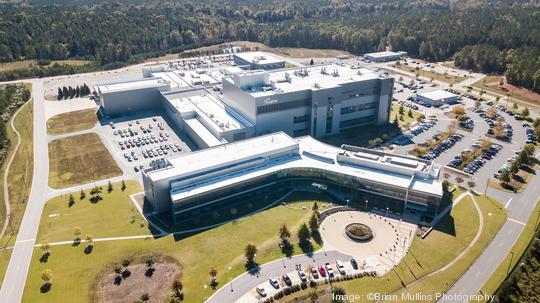
Even as new variants of Covid-19 continue to threaten the public health, researchers in laboratories all over the country are working to offset the next global health crisis. And that includes in the Triangle, where scientists say they need more resources – more money, more capacity and more collaboration.
The Triangle's position in the space is not new – though it’s been given a global spotlight in the Covid era.
In July 2020, Vice President Mike Pence highlighted the push for Operation Warp Speed – the federal effort to expedite Covid-19 vaccine production – during a visit to the Triangle, meeting with the M3-Wake Research team in Research Triangle Park as it kicked off the nation’s first Phase III clinical trial for a Covid-19 vaccine.
The location picked for that announcement was significant, said Doug Edgeton, president and CEO of the North Carolina Biotechnology Center. It signaled that North Carolina – and specifically the Triangle – would be a key location in the fight against the current pandemic and future outbreaks.

Jeff Wolf, CEO of Heat Biologics (Nasdaq: HTBX) in Morrisville, said it’s only a matter of time before the next pandemic hits – but it remains to be seen whether the lessons learned from Covid will stick.
“We need to – both as a company but also as a nation – look beyond what’s going on with Covid-19 for other potential biological threats, and there are many out there,” he said. “Covid-19 is relatively mild compared to potential biothreats on the horizon, especially the potential for manmade biothreats. … Quite frankly, I don’t think we’re prepared at all as a nation for these emerging biothreats.”
Fighting future pandemics takes partnership. It takes big checks and a long memory, said Ralph Baric, a professor at UNC-Chapel Hill and one of the world’s leading experts on coronaviruses.
“Priorities change over the function of time,” he said. “People forget … the horrors of the scenario fade over time.”
Baric said that right now there’s a lot of interest both from the government and private corporations in developing broad-based treatments for future pandemics. Traditionally, it’s been hard at times to get companies interested in developing drugs against diseases that have yet to emerge.
“There are so many different variants,” he said, noting that firms have to answer to their investors and stockholders. “They have no idea whether a market exists or whether anybody would purchase the product … They have to be responsible.”
Federal programs help, providing blocks of money to purchase drugs and put them on the shelf for future pandemics. Baric points to national stockpiles, particularly when it comes to flu vaccines. But there are a lot of pandemic possibilities – and thwarting them through innovation requires constant prioritization. “It really takes a combination of an academic, philanthropic and corporate partnership,” he said.
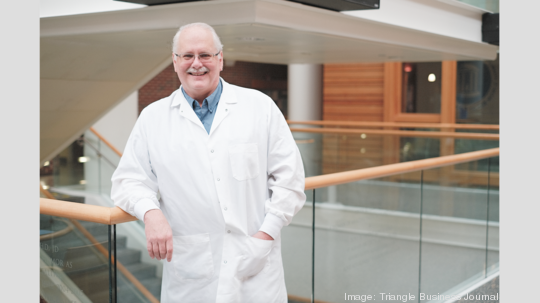
There is a push to create more public-private partnerships to address the central issues.
At UNC-Chapel Hill, for example, a partnership between scientists at the UNC School of Medicine, the UNC Eshelman School of Pharmacy and the UNC Gillings School of Global Health – dubbed Rapidly Emerging Antiviral Drug Development Initiative (READDI) – was created to start those discussions and figure out how to have drugs ready for future pandemics.
It’s just one local effort. Much is being done in UNC’s laboratories too, where scientists previousy helped to develop and test Gilead Science’s (Nasdaq: GILD) remdesivir, a coronavirus treatment Baric said could play a major role in future pandemics.
At labs across the Triangle, similar efforts are underway, further underscoring how crucial Triangle innovation really is.
Building a foundation
Similarly to how Pfizer (NYSE: PFE), Moderna (Nasdaq: MRNA) and Johnson & Johnson (NYSE: JNJ) relied on years-worth of platform research as they pushed out their vaccine plans, researchers at companies like Heat Biologics are trying to put together frameworks for future treatments and vaccines. But how do you start the framework to invent something when you don’t know the particulars about the threat?
That’s where the term “platform” comes in, referring to broad-reaching technology that has a slew of potential applications. Edgeton said that it’s part of why federal dollars go into treating so many diseases that, on the surface, may seem obscure.
Platform technologies to treat one specific ailment could create some kind of mechanism that could come into play for something else entirely. And in North Carolina, there are plenty of firms working on what he calls “foundational research.” It’s legwork being done now that could expedite future treatments, which could prove critical considering how quickly some diseases can spread, he said. The fact that North Carolina has so much of that research taking place – from genetic research to traditional clinical development – puts it in a key spot to become a major player when it comes to a variety of threats.
Heat Biologics is one of those companies. The firm, which has 40 employees, develops therapies to modulate the immune system. It’s developed what it calls its “gp96 platform,” designed to activate immune responses against cancer or infectious diseases. And it has multiple product candidates in development that leverage that platform, from oncology products that would stimulate T-cells to treat cancer to a preclinical Covid-19 vaccine program. It’s targeted treatments against Zika, Malaria and even HIV.
Wolf, Heats CEO, has a broad vision for the future of the platform, which he said can be adaptable to respond to future biologic threats – including viruses the public hasn’t yet fathomed.
“We haven’t really disclosed too much on it,” he said. “But a new platform based upon gp96 enables us to really generate much more real time defenses against biological threats that have emerged or will emerge in the future. What we’re doing now as a company is laying the foundation for this.”
That includes through a subsidiary, called Blackhawk, that's focused on biothreats – and an advisory board compiled of heavy hitters in the space, such as David Lasseter, a former deputy assistant secretary of Defense for Countering Weapons of Mass Destruction.
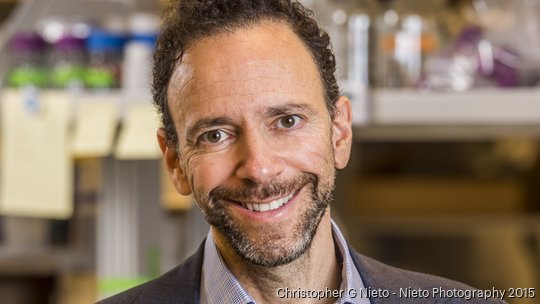
Similarly, a variety of vaccine manufacturers are working on ways to protect the public. In Holly Springs, a lot of the work surrounds influenza – and many conversations have been had about the potential for a future flu pandemic, said Roberta Duncan, who heads up the mRNA program at Seqirus, a vaccine maker with 900 employees in Holly Springs. Duncan said an advantage her firm is providing in the fight is multiple methodologies – platforms that could cast a wide net of protection.
mRNA vaccines, which have gotten a lot of press for their use against Covid-19, are one avenue Seqirus is exploring, working in conjunction with the federal government to thwart a potential future influenza outbreak.
On Thursday, the firm announced plans to accelerate the development of self-amplifying messenger RNA, its next-generation technology. The technology takes mRNA a step further, instructing the body to replicate mRNA. As a result, vaccine manufacturers could potentially develop more effective vaccines that require a smaller dosage and have lower risk of negative reactions. Seqirus is planning to initiate clinical trials of its sa-mRNA candidate next year.
"What’s really interesting about this platform is that you’re able to leverage this platform in multiple, multiple viruses,” Duncan said, noting that Seqirus hopes to be able to respond with multiple products, should a devastating flu pandemic emerge.
Variety is key when trying to get the entire population vaccinated. Edgeton, with NC Biotech, points to Medicago, which, armed with federal dollars, worked to create a vaccine alternative that doesn't use hen eggs – which are used in the production process for most seasonal flu vaccines. At the feds’ urging, Medicago is developing a platform using tobacco leaves instead.
Edgeton said that by researching a variety of platforms, the industry is leveraging its bets.
“The question we’re wrestling with is: what might the next pandemic look like?” he said.
North Carolina’s advantage is in its variety, he said. It has it all – from gene therapy startups to big pharma.
And the state's role keeps getting bigger. In just the past several months, multiple pharmaceutical firms have announced investments in the Triangle, from Eli Lilly (NYSE: LLY) in Durham to Fujifilm Diosynth Biotechnologies in Holly Springs.
Addressing the challenges ahead
Two of the industry’s biggest challenges – both magnified in the recent pandemic – are capacity constraints and supply chain interruptions. And North Carolina has resources available to respond to both – and to actually create jobs in the process, according to experts TBJ talked with.
The pharmaceutical industry can only make as much product as it has production lines.
“There’s a true dearth of biological manufacturing capacity in the U.S.,” Wolf said.
Chris Frech, chair of the Alliance for Biosecurity, echoed the sentiment.
“Clearly understanding and recognizing the need to have capability and capacity to both develop and manufacture products at scale, it’s a challenge … and Covid has demonstrated a scale that no one really envisioned,” he said.
North Carolina – in housing a slew of life sciences manufacturing operations – already has resources to support continued investment in capacity, from talent to many of the companies looking to expand their own outputs.
When it comes to supply chain – something virtually every pharma and biotech firm is evaluating in Covid-19’s wake, according to Edgeton – the opportunities keep coming.
And companies are taking advantage – from firms like BioAgilytix, which has been investing in increasing its own capacity – to companies like Fujifilm Diosynth Biotechnologies, which recently announced plans for a major biologics facility in Holly Springs.

“I do think we have a very strong opportunity,” Edgeton said. “You’re already seeing some of the results of people wanting to be in the supply chain – and in the North Carolina market, because we have the workforce.”
But complacency could push the state back. North Carolina has a lot of the elements to attract even more investment – it just has to keep delivering. Edgeton points to the workforce talent pool, as well as the proximity to university research and biotech competitors as creating the kind of cluster that firms find attractive when they’re looking for sites.
Economic incentives, too, could come into play. Fujifilm, for example, was lured to North Carolina over a competing site in Texas, in part due to a state incentives package worth more than $19.7 million. While there’s debate among academics as to whether incentives work out to be good math for the state, economic developers repeatedly call incentives crucial when it comes competing against other talent rich areas such as San Francisco and Boston.
Wolf said that investments by both the community and the state will be critical in keeping the innovators coming – and investing – in the Triangle.
The same can be said for funding next generation treatments and vaccines, said Frech with the Alliance for Biosecurity.
“The government can’t do this on their own and industry is not really willing to step forward without some sense of certainty in understanding what’s needed,” he said. “The operative word in there is 'partnership.' It’s not a vendor relationship. It’s not simply buying products. It’s often bringing forward resources, both from an industry perspective and from a government perspective.”
He said constant conversations are needed between both private and public players to identify potential health threats. Frech said there are always competing funding priorities and, historically, there have been challenges in financing preparations. But he said one thing the pandemic has done is raise the public’s consciousness – which could be critical for future funding.
“Covid has been a real eye opener for us in the space,” he said.
Frech said the next challenge could be maintaining the capacity that Covid has shown the nation, and world, it needs.
“It’s keeping [protocols] in place and keeping the investment going so that they are going to be available when we do need to turn to them,” he said.

